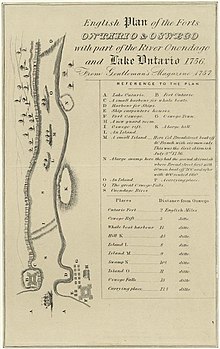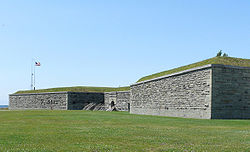Fort Ontario
Fort Ontario | |
 View from Fort Ontario | |
| Location | 1 E. 4th St. and Lake Ontario, Oswego, New York |
|---|---|
| Coordinates | 43°27′57″N 76°30′29″W / 43.46583°N 76.50806°W |
| Area | 36 acres (15 ha) |
| Built | 1839 |
| NRHP reference No. | 70000426[1] |
| NYSRHP No. | 07540.000009 |
| Significant dates | |
| Added to NRHP | December 18, 1970 |
| Designated NYSRHP | June 23, 1980 |
Fort Ontario is an American historic bastion fort situated by the City of Oswego in Oswego County, New York. It is owned by the state of New York and operated as a museum known as Fort Ontario State Historic Site. Fort Ontario is located on the east side of the Oswego River on high ground overlooking Lake Ontario.
18th century
[edit]
Fort Ontario was one of several forts erected by the British to protect the area around the east end of Lake Ontario. The original Fort Ontario was erected in 1755, during the French and Indian War, in order to bolster defenses already in place at Fort Oswego on the opposite side of the river. At that time its name was the "Fort of the Six Nations," but the fort was destroyed by French forces during the Battle of Fort Oswego in 1756 and rebuilt by British forces in 1759.[3]: 3
At the conclusion of Pontiac's War, Pontiac urged moderation and agreed to travel to New York, where he made a formal treaty with William Johnson at Fort Ontario on July 25, 1766.
During the American Revolutionary War, a detachment from the 3rd New York Regiment destroyed the fort in July, 1778, after the British abandoned it. The British returned and rebuilt the fort in 1782. There was an aborted attack on the fort by Colonel Marinus Willet in 1783. The British held the fort after the war was over until 1796 after the signing of Jay's Treaty.[3]
19th century
[edit]The fort was attacked and destroyed by British forces during the War of 1812 in the year 1814. After a period of disuse, new construction was undertaken in part because of tensions with Great Britain as well as to check smuggling activities between Canada and the United States.
During the American Civil War the new construction began at the fort because of fear of British help from Canada to the Confederacy. After the American Civil War it held Company F, 42nd Infantry which consisted of wounded soldiers from the war that had reenlisted in the U.S. Army. Although the fort remained a military base, the fort itself fell into ruin, since funds were used to create more modern quarters outside the fort.
20th century
[edit]When the United States entered World War I in April 1917, the fort was repurposed as a military hospital, known as General Hospital No. 5. The facility was used to train medical personnel before they were posted to France.[4]
In 1921, the fort again became an infantry base, initially the 28th Infantry Regiment and in 1933, the 2nd Brigade of the U.S. 1st Infantry Division called Fort Ontario home until the brigade was deactivated on June 1, 1940. During this period, some of the historic buildings inside the fort were restored and a golf course was laid out on the grassy ramparts.[5]

In 1940, the fort was refurbished as an induction center for new conscripts with 60 new buildings for 3,000 men, but it was used instead as a base for several National Guard anti-aircraft units. As America entered World War II, Fort Ontario was repurposed again as a training center for African American military police.[6]
Later in the war, the fort was home to 982 Jewish refugees, from August 1944 to February 1946. The Fort Ontario Emergency Refugee Shelter was the only attempt by the United States to shelter Jewish refugees during the war. After the end of the war the refugees were kept in internment because of disagreements concerning whether or not to allow them to become United States citizens. In January 1946, the decision was made to allow them to become citizens, and by February all of the Jewish refugees were allowed to leave Fort Ontario.[7]
Current use
[edit]Although closed by the U.S. Army after World War II, some of the buildings at Fort Ontario are still used for training by the Army Reserve.
The restored fort is open to the public as a state historic site. It was listed on the National Register of Historic Places in 1970.[1] In 2010, Fort Ontario was one of the state-funded historical sites named by Governor David Paterson as being potentially unfunded because of the budget crisis faced by New York State. In response, many of the citizens of Oswego and students of the State University of New York at Oswego have joined together in support of the historical site.
The Safe Haven Holocaust Refugee Shelter Museum operates in a building south of the fort.
Description
[edit]
The present fortifications are built on a pentagonal plan with five bastions, similar to the layout of Fort Jackson, Louisiana. It was designed for heavy cannon mounted en barbette (i.e. in the open firing over the parapet), but howitzers were mounted in casemates built into the ramparts of the bastions. The stone-faced scarp walls of the bastions were also pierced with loopholes for rifle fire, which are of varying design, reflecting the preferences of the different engineers overseeing the construction. Originally, a ravelin protected the side of the fort facing Lake Ontario and mounted further heavy guns.[8]
The current layout of the fort includes Officer Quarters #1, the Powder Magazine, the Enlisted Men's Barracks, the Storehouse, and Officer Quarters #2. There are also two guardhouses by the entrance of the tunnel to the main entrance.[9]

See also
[edit]References
[edit]- ^ a b "National Register Information System". National Register of Historic Places. National Park Service. July 9, 2010.
- ^ "English Plan of the Forts Ontario & Oswego with part of the River Onondago and Lake Ontario 1756. From Gentleman's Magazine 1757 - Barry Lawrence Ruderman Antique Maps Inc". Barry Lawrence Ruderman. Retrieved 21 November 2022.
- ^ a b "Cultural Resource Information System (CRIS)". New York State Office of Parks, Recreation and Historic Preservation. Archived from the original (Searchable database) on 2015-07-01. Retrieved 2015-11-01. Note: This includes Chester Liebs (August 1970). "National Register of Historic Places Registration Form: Fort Ontario" (PDF). Retrieved 2015-11-01. and Accompanying photographs
- ^ Reed, George A.; Reed, Carol (2000). Fort Ontario: Guardian of the North. Charleston, SC: Arcadia Publishing. p. 49. ISBN 978-0738502847.
- ^ Reed & Reed 2000, pp. 63-66
- ^ Reed & Reed 2000, pp. 63-66
- ^ "OUR STORY". www.safehavenmuseum.com. Safe Haven Holocaust Refugee Shelter Museum. Retrieved July 25, 2021.
- ^ Weaver, John (30 June 2018). A Legacy in Brick and Stone: American Coast Defense Forts of the Third System, 1816-1867. McLean, VA: McGovern Publishing. p. 78. ISBN 978-1732391611.
- ^ "Virtual Tour". Historic Fort Ontario. 2013-11-24. Retrieved 2019-08-09.
- Graymont, Barbara, The Iroquois in the American Revolution, 1972, ISBN 0-8156-0083-6
External links
[edit]- American Revolutionary War forts
- Forts in New York (state)
- French and Indian War forts
- New York (state) historic sites
- Museums in Oswego County, New York
- Military and war museums in New York (state)
- Living museums in New York (state)
- British forts in the United States
- Colonial forts in New York (state)
- Jewish-American history
- Oswego, New York
- Forts on the National Register of Historic Places in New York (state)
- National Register of Historic Places in Oswego County, New York
- American Revolution on the National Register of Historic Places
- Military history of the Great Lakes
- New York State Register of Historic Places in Oswego County




